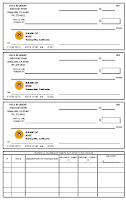Next we will explore the general layout of a personal check:
Finally we will do a quick simulation of writing checks and using a check register. I will be passing out a worksheet with three checks and a register (you can view a copy here: Checks with Register). Use the following scenario to complete your worksheet:
- You begin your checking account today (12/02/16) with $135.72 from your piggy bank.
- You receive a Check for $550.00 from your work and Deposit it to your checking account on 12/03/16.
- Write a Check for your rent on 12/04/16 for $425 to Jellico Green Apartments.
- You go to dinner at The Pizza Spot on Saturday Night (12/05/16) for $18.27 and use your Debit Card.
- You send a Check to Edward Teach in the amount of $31.19 on 12/06/16 for a pair of shoes you bought on eBay.
- You receive a Check for $550.00 on 12/17/16 from your work and you Deposit it to your checking account that afternoon.
- You write a Check for your car payment to Airport Auto Brokers on 12/18/16 in the amount of $224.72.
- You use Online Banking to pay $124.25 for your Jellico Electric bill on 12/09/16.

Compare your ending balance with a neighbors to verify your accuracy.
Here are a couple video clips to explore:












































